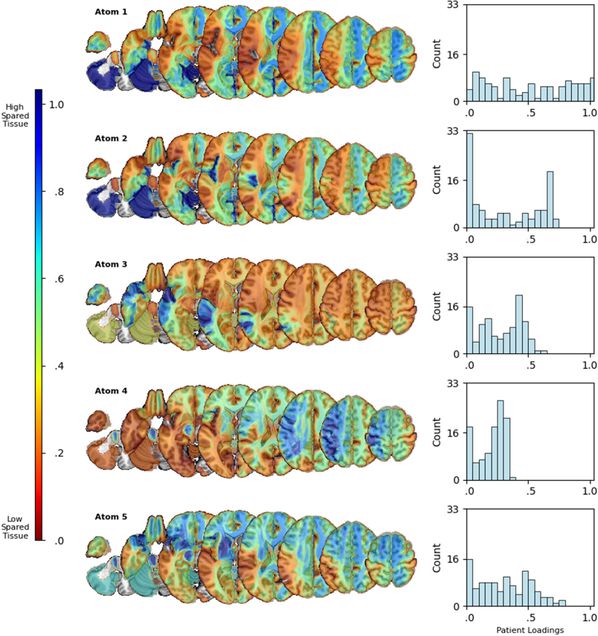Kropp, E., Varkanitsa, M., Carvalho, N., Falconer, I., Billot, A., Al-Dabbagh, M., & Kiran, S. (2025). Using unsupervised dimensionality reduction to identify lesion patterns predictive of post-stroke aphasia severity. Cortex, 188, 25–41. https://doi.org/10.1016/j.cortex.2025.04.015
Read Paper
Abstract
Although voxel-based methods consistently identify brain regions associated with specific language functions, these techniques are limited when applied to broader behavioral measures. To better represent effects of lesions on distributed brain regions, we used a data-driven approach called non-negative matrix factorization (NMF) to identify representative stroke patterns and explore associations with aphasia severity. Lesions were segmented using structural MRIs for 107 left hemisphere stroke patients, and the Western Aphasia Battery – Revised Aphasia Quotient (AQ) was used to quantify aphasia severity. Percent spared tissue was calculated in left hemisphere white and gray matter regions. By applying NMF to spared tissue data, we identified 5 NMF ‘atoms’ which represent prototypical stroke patterns across this dataset. Linear regression was used to identify whether certain stroke patterns were associated with aphasia severity, adjusted for lesion volume and demographics. Two NMF atoms showed relevance in predicting AQ: strokes with low spared tissue across the whole MCA territory were associated with more severe aphasia, but strokes with high spared tissue around the insula were associated with less severe aphasia. We also identified a pattern of high spared tissue in superior fronto-parietal regions, where lesion volume was more strongly associated with severity as a result of isolating damage to more critical language areas. These representative stroke patterns offer a new way to combine information about lesion burden and location and explore anatomical associations with language dysfunction in stroke.

Q&A with Emerson Kropp
What is this paper about and why are the results important?
This paper focuses on a novel approach for identifying prototypical stroke patterns across patients, then determining what specific stroke patterns are associated with language impairment. This allows researchers to better predict the effects of a large-scale stroke on behavioral impairment and recovery.
How do the findings relate to the brain and recovery?
These results shed light on ways in which specific stroke patterns which patients may present with will affect behavior, and further work with this technique could identify stroke patterns with greater or less capacity for recovery–targeted treatment based on these findings could therefore lead to preserving brain regions which allow patients to retain or regain more function in the future.
